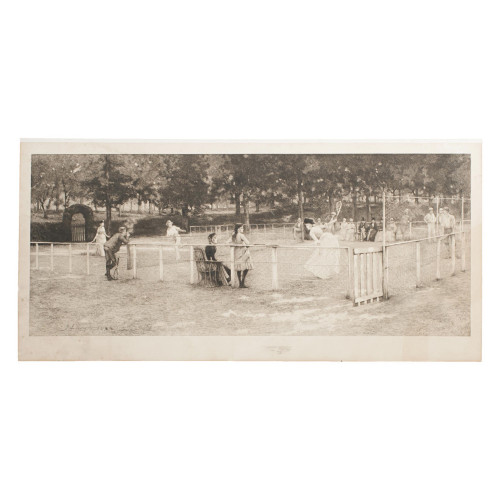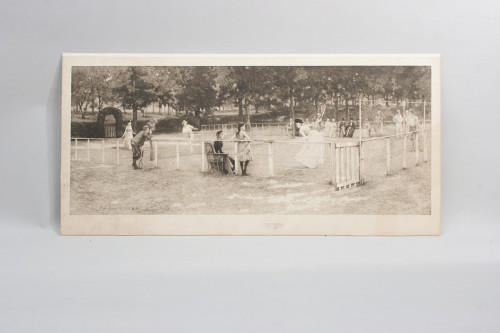- Home
- Artists & Makers
- Sir John Lavery
Sir John Lavery

1856 - 1941
Sir John Lavery RA RSA RHA was an Irish painter celebrated for his portraits, society scenes, landscapes, and wartime depictions. Born in inner North Belfast on 20 March 1856, he was baptised at St Patrick's Church and orphaned at a young age, later raised by relatives in Moira, County Down. As a child he moved to Scotland and studied at the Haldane Academy in Glasgow during the 1870s. In 1878 he opened his own studio, which was destroyed by fire the following year. Using the insurance payout, Lavery trained at Heatherley's School of Fine Art in London and later at the Académie Julian in Paris, where he absorbed the influence of French naturalism and impressionism. Returning to Glasgow in the early 1880s, Lavery became associated with the Glasgow Boys, a progressive group of artists who challenged academic conventions. His breakthrough came in 1888, when he was commissioned to paint Queen Victoria's state visit to the Glasgow International Exhibition. The success of this work established his reputation as a society painter, and he soon relocated to London. Over the following decades, his elegant portraits of aristocrats, politicians, and cultural figures-including Winston Churchill, H. H. Asquith, Lord Derby, John Redmond, and Edward Carson-were widely admired and collected. Lavery's personal life was marked by both tragedy and devotion. His first wife, Kathleen MacDermott, whom he married in 1889, died of tuberculosis in 1891 shortly after the birth of their daughter, Eileen (later Lady Sempill). In 1909 he married Hazel Martyn, an Irish-American celebrated for her
Sir John Lavery RA RSA RHA was an Irish painter celebrated for his portraits, society scenes, landscapes, and wartime depictions. Born in inner North Belfast on 20 March 1856, he was baptised at St Patrick's Church and orphaned at a young age, later raised by relatives in Moira, County Down. As a child he moved to Scotland and studied at the Haldane Academy in Glasgow during the 1870s. In 1878 he opened his own studio, which was destroyed by fire the following year. Using the insurance payout, Lavery trained at Heatherley's School of Fine Art in London and later at the Académie Julian in Paris, where he absorbed the influence of French naturalism and impressionism. Returning to Glasgow in the early 1880s, Lavery became associated with the Glasgow Boys, a progressive group of artists who challenged academic conventions. His breakthrough came in 1888, when he was commissioned to paint Queen Victoria's state visit to the Glasgow International Exhibition. The success of this work established his reputation as a society painter, and he soon relocated to London. Over the following decades, his elegant portraits of aristocrats, politicians, and cultural figures-including Winston Churchill, H. H. Asquith, Lord Derby, John Redmond, and Edward Carson-were widely admired and collected. Lavery's personal life was marked by both tragedy and devotion. His first wife, Kathleen MacDermott, whom he married in 1889, died of tuberculosis in 1891 shortly after the birth of their daughter, Eileen (later Lady Sempill). In 1909 he married Hazel Martyn, an Irish-American celebrated for her
beauty and poise. Hazel became his muse, appearing in more than 400 of his works, and her image later adorned Irish banknotes.
During the First World War, Lavery was appointed an official war artist. Although illness and a car accident during a Zeppelin raid prevented him from travelling to the Western Front, he contributed significant works depicting naval fleets, aircraft, and home-front scenes, many of which entered the collection of the Imperial War Museum. He was closely connected with the Asquith family during these years, capturing both formal portraits and intimate domestic scenes.
In recognition of his achievements, Lavery was knighted in 1918 and elected to the Royal Academy in 1921. His career remained highly distinguished, and his paintings even featured in the art competitions of the 1924, 1928, and 1932 Summer Olympics. He continued working prolifically until his death at Rossenarra House, Kilmoganny, County Kilkenny, on 10 January 1941.
Lavery's legacy lies in his ability to combine modern impressionist influences with an accessible naturalism. Whether painting society portraits, leisure scenes, or the machinery of war, his art captured both the elegance and the turbulence of late 19th- and early 20th-century life.
Adapted from Wikipedia
1 ITEM
Please create wishlist to add this item to


